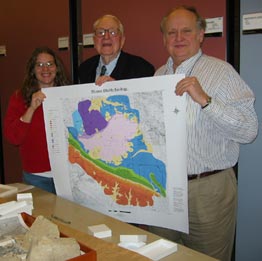Analyzing the fossils of Mt. Diablo(page 1 of 3) |
||
|
Mt. Diablo is one of the Bay Area’s best-known natural landmarks. It boasts unbelievable views,
abundant wildlife, sculpted sandstone caves, and a maze of recreational trails maintained by the
Mt. Diablo State Park. The park also has a rich and complex geologic history, recording much of
California’s past life and geologic events. Rocks within the park represent a variety of
paleoenvironments, from deep ocean and shallow marine to continental and fluvial, ranging in age
from Jurassic (~190 million years ago) to Late Miocene (~8 million years ago). To better understand
this record and its significance, the State Park contacted UCMP in early 2001 to ask for help in
evaluating the paleontological resources of the park, and to assist in the development of an
effective management plan. As this seemed a perfect project for a graduate student, Dave Lindberg,
Director of UCMP, approached Sarah Rieboldt to see if she might be interested. Knowing that she
would get to hike around a beautiful park, learn about the local geology, and get paid to do so,
Sarah agreed to take on the job. |
 Sarah Rieboldt (left) shares one of her maps with UCMP alum and Friend, Nestor John Sander (center), who worked on sites in the Mt. Diablo area in 1936, and Director, David Lindberg. (photo by Judy Scotchmoor) of more than 455 species. Sarah compiled a list of who collected what, where, and when, while noting the geologic interpretations made at that time. She then set about organizing her efforts geographically so that she could field check 4–5 localities each day. It became clear that the undertaking had been enormously underestimated, and what was scheduled to be a 12-month project turned out to be an 18-month investment of time, albeit a very worthwhile one.
|
|